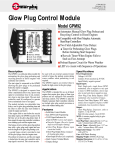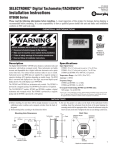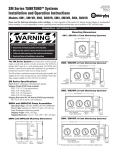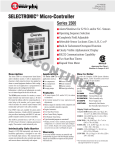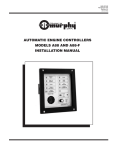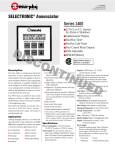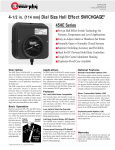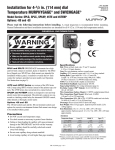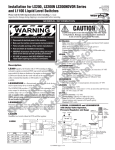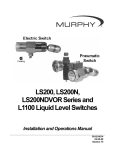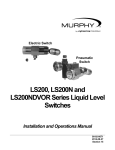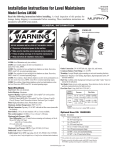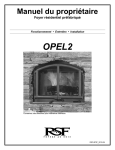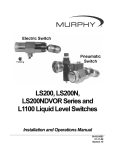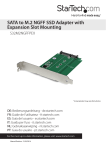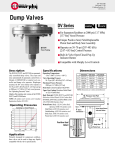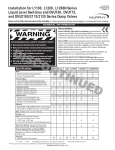Download Murphy LLS User's Manual
Transcript
LLS, LLSB, LLSR, LLSRB Series Models Lead Line Pressure Switches Installation and Operation Instructions LLS-93096N Effective 03-94 Section 05 ® FRANK W. MFR. Please read the following information before installing. A visual inspection of this product for damage during shipping is recommended before mounting. It is your responsibility to have a qualified person install the unit and make sure installation conforms to NEC and local codes. GENERAL INFORMATION WARNING BEFORE BEGINNING INSTALLATION OF THIS MURPHY PRODUCT ✔ ✔ ✔ ✔ Disconnect all electrical power to the machine. Make sure the machine cannot operate during installation. Follow all safety warnings of the machine manufacturer. Read and follow all installation instructions. LLS Series Pressure Switch Description • Sensor Body: LLS: CRS steel chromate plated; 2 in. NPT connection. The LLS Series is a pressure switch for applications where viscous liquids could plug the sensing orifice. LLS and LLSB models have a 2 inch NPT male connection which attaches directly into the process line. LLSR and LLSRB models feature a remote sensor connected to the pressure switch by a length of stainless steel capillary and armor. The snap-acting switch is field adjustable. The switch is housed in a hard anodized aluminum enclosure. Optional for LLSR and LLSRB models is a 1 inch NPT x 1 inch NPT (male) pulsation dampener to minimize damaging pressure pulsation to the switch. LLSB: Thick wall 304 stainless steel sensor 2 in. NPT process connection. LLSR: Remote Sensor; Nickel plated steel, stainless steel capillary. LLSRB: Remote Sensor; 316 stainless steel housing and capillary. • Diaphragm Materials: LLS/LLSB: Ni-SPAN®. LLSR/LLSRB: 316L S. Steel–Teflon* coated. • Snap-switch Ratings: SPDT (Std.): 15 A @ 125, 250 or 480 VAC SPDT (Gold): 100 mA @ 125 VAC; 0.250 A @ 6 VDC DPDT (Std.): 11 A @ 125 or 250 VAC DPDT (Gold): 100 mA @ 125 VAC; 0.250 A @ 6 VDC • Trip Point Adjustment: Field-adjusted with screwdriver. • LLSR/LLSRB Mount: 4-hole bolt pattern; 1/4 in. (6 mm) dia. bolts. • LLS/LLSB Mount: Direct mount into process (2 in. NPT connection). Specifications • Maximum Ambient Temperature: -10° to +160°F (-23° to +71°C). • Maximum Process Temperature: -40° to +160°F (-40° to +71°C). • Temperature Compensation: The volumetric expansion and contraction of the fill may cause a shift of ±3% to ±5% of the set point. • Switch Enclosure: Aluminum hard anodized (black). NEMA 4, 4x. NEMA 7 and 9 explosion-proof, waterproof and corrosion resistant. Suitable for Class I, Div. 1, Groups A, B, C, D; Class II, Div. 2, Groups E, F, G. • Shipping Weight: LLS/LLSB: 4 lbs. 9 oz. (2.25 kg). LLSR/LLSRB: 7 lbs. 12 oz. (3.23 kg). • Shipping Dimensions: LLS/LLSB: 10 x 9-1/4 x 5-3/4 in. (254 x 235 x 146 mm). LLSR/LLSRB: 15-3/4 x 11 x 5-1/4 in. (400 x 279 x 133 mm). Sensor Model Selection Table Base Model LLS LLSB LLSR LLSRB Switch Adjustment Range psi kPa/MPa 50–450 345 kPa–3.1 MPa 100–1750 689 kPa–12 MPa 200–2500 13.8 MPa–17.2 MPa 400–4000 2.8 MPa–27.5 MPa 50–450 345 kPa–3.1 MPa 100–1750 689 kPa–12 MPa 200–2500 13.8 MPa–17.2 MPa 400–4000 2.8 MPa–27.5 MPa 50–450 345 kPa–3.1 MPa 100–1750 689 kPa–12 MPa 200–2500 13.8 MPa–17.2 MPa 50–450 345 kPa–3.1 MPa 100–1750 689 kPa–12 MPa 200–2500 13.8 MPa–17.2 MPa 400–4000 2.8 MPa–27.5 MPa Dead Band Approximate psi kPa/MPa 5–45 34 kPa–310 kPa 15–100 103 kPa–689 kPa 20–150 137 kPa–1.03 MPa 75–450 517 kPa–3.1 MPa 5–45 34 kPa–310 kPa 15–100 103 kPa–689 kPa 20–150 137 kPa–1.03 MPa 75–450 517 kPa–3.1 MPa 5–45 34 kPa–310 kPa 15–100 103 kPa–689 kPa 20–100 137 kPa–689 kPa 5–45 34 kPa–310 kPa 15–100 103 kPa–689 kPa 20–150 137 kPa–1.03 MPa 75–450 517 kPa–3.1 MPa Max System psi MPa 1500 10.3 2500 17.2 3000 20.6 5000 34.4 1500 10.3 2500 17.2 3000 20.6 5000 34.4 1500 10.3 2500 17.2 3000 20.6 1500 10.3 2500 17.2 5000 34.4 5000 34.4 Wetted Parts Materials CRS steel sensor –chromate plated (yellow) Ni-SPAN® diaphragm. Thick wall 304 stainless steel sensor housing; Ni-SPAN® diaphragm. Meets NACE MR-01-75 standard for direct exposure to H2S. Remote sensor–Nickel plated steel w/ stainless steel capillary; Teflon* coated diaphragm. Remote sensor–AISI 316 stainless steel housing; stainless steel capillary and armor; AISI 316L stainless steel Teflon* coated diaphragm. * Teflon–DuPont Trademark 1 DIMENSIONS LLS and LLSB Models Complete Unit Front View Switch Enclosure Top View 3 in. (76 mm) Switch Enclosure 9-1/4 in. (235 mm) MAX. Switch Trip Point Adjustment Panel 2-9/64 in. (54 mm) 7/8 in. (22 mm) 1-1/2 in. (38 mm) 3/4-14 NPT Conduit Inlet Sensor Enclosure End View Do NOT Tamper with these Sealed Connections Sensor Body 2-1/2 in. (64 mm) MAX. 2 in. NPT Process Connection Diaphragm LLSR and LLSRB Models Sensor Enclosure Front View Switch Enclosure Front View Transmitting tube 6-1/2 in. (165 mm) MAX. LLSR models: 3-3/4 in. (95 mm) dia. LLSRB models: 3-7/8 in. (98 mm) dia. Switch Enclosure Switch Trip Point Adjustment Panel Sensor Body 2-7/8 in. (73 mm) 1-13/16 in. (46 mm) 3/4 in. (19 mm) 1 in. NPT (female) Connection 17/64 x 1/2 in. (7 x 13 mm) mounting holes (4 places) Pulsation Dampener PD8187 Option 2-1/2 in. (64 mm) Do NOT Tamper with these Sealed Connections 2 Transmitting tube, 5 feet (1.524 m) std. 3-7/8 in. (98 mm) FLOW 3-1/2 in. (89 mm) 1 in. NPT (male) Process Connection 2 places INSTALLING THE LLS SERIES PRESSURE SWITCH WARNING: PERFORM THE INSTALLATION WITH POWER SOURCE “OFF”. NEVER EXCEED RATED PRESSURE RANGE FOR THE UNIT. USE WRENCH ON SHANK TO TIGHTEN/LOOSEN CONNECTIONS. DO NOT TWIST THE ENCLOSURE WHEN SCREWING THE LLS INTO THE PROCESS – THIS WILL DAMAGE INTERNAL COMPONENTS, FILLED MECHANISM AND THE SEALS. DO NOT OVERTIGHTEN THE UNIT. Connecting the LLS and LLSB Series To install the LLS and LLSB Series, a vertical mounting is recommended. 1. The unit threads directly into a 2 in. 11-1/2 NPT tee on the lead line. CAUTION: DO NOT TAMPER WITH OR BREAK SEALED CONNECTIONS. APPLY PIPE SEALANT TO PROCESS CONNECTION THREADS. Figure 1 Do NOT Tamper with these Sealed Connections Do NOT Tamper with This Connection Wrench Flats Use Wrech Flats to Screw the LLS Into the Process 2 in. NPT 2. Tighten the bottom housing to the lead line tee using ONLY the transmitter wrench flats (see figure 1). Lead line tee 3. Check for leakage on any of the connections. Make sure that the installation conforms with local and other applicable codes. Connecting the LLSR and LLSRB Series For mounting the switch enclosure refer to “Dimensions” on page 2. The following instructions are based on the usage of a PD8187 Pulsation Dampener option shown in Figure 2 (at right.) 1. Install sensor/pulsation dampener into pressure source connection. Figure 2 Transmitting Tubing (capillary) Housing Bolts CAUTION: THE PD8187 PULSATION DAMPENER IS NOT INTENDED Diaphragm Body Wrench Flats AS A SHUTOFF VALVE. APPLY PIPE SEALANT TO THE THREADS. 2. Loosen the eight housing bolts until the bottom housing is free to turn. CAUTION: WHEN LOOSING THE EIGHT HOUSING BOLTS, MAKE Pulsation Dampener (optional) SURE NOT TO UNSCREW THE GREEN DIAPHRAGM CAPSULE. 3. Tighten the bottom housing to the pulsation dampener connection. 4. Tighten the eight housing bolts to 25±3 foot lbs. Stagger the tightening to assure even clamping. 5. Route capillary away from heat source (exhaust manifold). Excess capillary should be carefully coiled and secured (do NOT cut it). 1 in. NPT Lead Line Tee WIRING THE LLS SERIES PRESSURE SWITCH WARNING: PERFORM THE WIRING OPERATION WITH THE POWER SOURCE “OFF”. MAKE SURE VOLTAGE AND CURRENT REQUIREMENTS ARE WITHIN THE LLS RATINGS. BEFORE WIRING THE UNIT DETERMINE VOLTAGE AND POLARITY FOR THE APPLICATION. IF THE UNIT IS USED IN HAZARDOUS AREAS, MAKE THE AREA SAFE BEFORE REMOVING THE SNAP-SWITCH(ES) COVER. If switch trip point needs to be adjusted, see page 4. LLS Series Hook-up (all models) To wire the LLS Series, use proper the electrical conduit. 1. A 3/4''-14 NPT inlet connection for conduit installation is provided at the top end of the switch enclosure (see opposite page– “Dimensions” for location). NOTE: The plastic plug (supplied) is to protect the conduit inlet threads and must be removed before wiring the unit. 2. Using a 3/16 in. hex wrench, unscrew the 4 hex-cap screws. Now proceed to remove the square cover to reveal snap-switch(es). 3. To wire the unit, refer to the typical wiring drawing (Figure 3) and to the Schematic (shown at right). Wire the LLS Series switch(es) with 60°/75°C (140°/167°F) insulated wire. 4. A terminal (inside the switch enclosure) is provided for case or equipment grounding, refer to Figure 3 for location. 5. After completing wiring, replace the switch cover and make sure it is tightly secured before applying power to the system. P P Schematic NC NC SPDT DPDT C NO C NO NC C NO Figure 3 Customer Wiring SPDT DPDT 3/4 in.-14 NPT Conduit Inlet N.O. N.C. COM. Provision for Case Ground NC NO C NC NO C Terminal Block(s) 3 ADJUSTING THE TRIP POINT CAUTION: REMEMBER THAT THE FIELD-ADJUSTABLE TRIP POINT MAY HAVE BEEN FACTORY SET TO YOUR SPECIFICATIONS. ADJUSTMENT OF THE TRIP POINT VARIES ACCORDINGLY TO THE APPLICATION AND MUST BE PERFORMED BY A QUALIFIED PERSON. LLS Series Trip Point Adjustment if necessary (all models) Figure 4 NOTICE: If trip point is not specified, the switch will be set at approximately 50% of full scale. To perform trip point re-adjustments, a test stand with variable pressure source, a test light, and a pressure gauge (such as our OPLG or OPLFG MURPHYGAGE®) may be used. Snap-switch(es) Cover or Square Cover Do NOT remove until the area is made NON-HAZARDOUS To Reset for Rising Pressure 1. Locate and remove the Switch Trip Point Adjustment cover (round) to reveal the Adjustment Wheel, (see figure 4). WARNING: DO NOT REMOVE SNAP-SWITCH COVER AT THE Screwdriver Adjustment Wheel INSTALLATION SIGHT UNTIL THE AREA IS MADE NON-HAZARDOUS. 2. After area is made non-hazardous, proceed to remove the square cover to reveal the snap-switch(es). 3. Connect test light to (COM) and (N.C.) terminals. The light should turn “ON”. Gradually increase the pressure until the light turns“OFF”. Observe the trip point pressure reading. 4. With a screwdriver, turn the adjustment wheel to the desired setting. Repeat step 4 until the light turns “OFF” at the desired pressure. To increase set point To decrease set point Switch Trip Point Adjustment Cover or Round Cover To Reset for Falling Pressure Follow step 1 and step 2 (above), then: 3. Connect test light to (COM) and (N.O.) terminals. The light should stay “OFF”. Gradually increase the pressure until the light turns“ON”. Observe the trip point pressure reading. 4. With a screwdriver, turn the adjustment wheel to the desired setting. Repeat step 4 until the light turns “OFF” at the desired pressure. Replace the adjustment and the switch covers securely. WARRANTY A two year limited warranty on materials and workmanship is provided with this Murphy product. Details are available on request and are packed with each unit. In order to consistently bring you the highest quality, full featured products, we reserve the right to change our specifications and designs at any time. ® FRANK W. Since 1939 MFR. ■ Frank W. Murphy Manufacturer P.O. Box 470248; Tulsa, Oklahoma 74147; USA tel. (918) 627-3550 fax (918) 664-6146 e-mail [email protected] ■ Frank W. Murphy Southern Division P.O. Box 1819; Rosenberg, Texas 77471; USA tel. (281) 342-0297 fax (281) 341-6006 e-mail [email protected] Printed in U.S.A. 4 ■ Frank W. Murphy, Ltd. Church Rd.; Laverstock, Salisbury SP1 1QZ; U.K. tel. +44 1722 410055 fax +44 1722 410088 tlx 477088 e-mail [email protected] ■ Frank W. Murphy Pte., Ltd. 26 Siglap Drive; Republic of Singapore 456153 tel. +65 241-3166 fax +65 241-8382 e-mail [email protected] ■ Murphek Pty., Ltd. 1620 Hume Highway; Campbellfield, Vic 3061; Australia tel. +61 3 9358-5555 fax +61 3 9358-5558 ■ Murphy de México, S.A. de C.V. Blvd. Antonio Rocha Cordero 300, Fracción del Aguaje San Luis Potosí, S.L.P.; México 78384 tel. +52-48-206264 fax +52-48-206336 e-mail [email protected] ■ Murphy Switch of California P.O. Box 900788; Palmdale, California 93590; USA tel. (805) 272-4700 fax (805) 947-7570 e-mail [email protected] ■ Frank W. Murphy France tel. +33 1 30 762626 fax +33 1 30 763989




